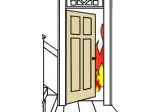
Fire doors are an important safety measure, and are required in homes used for commercial purposes, like those which feature a storefront or bed and breakfast setups.
The regulations for fire doors don’t apply to most residential buildings, as noted below:
- “‘Building’ means a fixed structure that is wholly or partly enclosed by walls and is roofed and includes a floating building and any part of a building but does not include -(a) a single dwelling house, being either a detached dwelling house or a town, terrace, row, villa or like house attached to another such house or other such houses only by a wall on 1 or more of its sides.” *

For this reason, it is unlikely that you will need to be concerned with installing a fire door in your home and any commercial building will need to be inspected by fire and safety inspectors first who will advise you of any requirements to install fire doors.
What is a fire door?
A fire door is a door that has been clearly marked and constructed in such a way as to provide an emergency exit from the building in case of a fire. These doors are able to be pushed open from the inside and are either very simple to unlock or not locked at all. They must be kept clear at all times for a two metre circumference around the exit and kept closed when not in use to comply with regulations. Clear signage needs to be displayed as well to ensure regulatory compliance.
Fire doors are often constructed of heavy materials, often with steel plating to maintain the door’s integrity under extreme temperatures. A push bar is usually equipped to limit the surface anyone fleeing the building needs to touch to open the door.
Fire doors and locks
There are specific requirements for the locks you’re able to attach to a fire door. The door has to be openable quickly in an emergency and not require anything like a key, so this rules out double cylinder deadbolts which require key entry from both sides. There are a range of approved lock types which can be safely installed on fire doors and still ensure regulatory compliance.
Where can I get more information?
More information about legal requirements can be obtained from your local fire service provider or inspector who can examine your specific needs and advise you on what you have to do to comply with applicable regulations.
* Source: Queensland Fire and Rescue Service (viewed 20/5/13)





